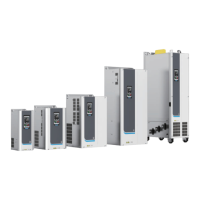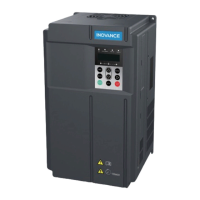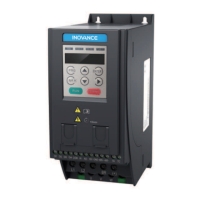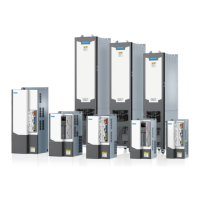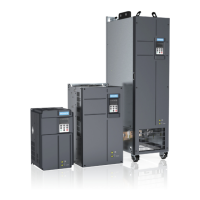Commissioning and Trial Run
‑57‑
2.2.13(Optional) PMVVC Parameters Settings
Parame
ter
Code
Parameter
Name
Value Range Default Description
F0‑01 Motor 1
control
mode
0: SVC
1: FVC
2: V/f
0 0: Sensorless vector control (SVC)
It is an open‑loop vector control mode, which is applicable
to high‑performance control applications. In this case, one
AC drive can drive only one motor. This mode applies to
such loads as machine tools, centrifuges, wire drawing
machines, and injection molding machines.
1: Feedback vector control (FVC)
It is a closed‑loop vector control mode. The motor must be
configured with an encoder and the AC drive must be
installed with a PG card matching the encoder type. This
mode is applicable to high‑accuracy speed control or
torque control applications. One AC drive can drive only
one motor. It is used for loads such as high‑speed
papermaking machinery, hoisting machinery, and
elevators.
2: V/f control (speed open‑loop control)
This mode is applicable to scenarios not requiring high
load control performance, such as fans and pumps. If one
AC drive is used to control multiple motors, only the V/f
control mode can be used.
F1‑00 Motor type 0: Common
asynchronous motor
1: Variable frequency
asynchronous motor
2: Permanent magnet
synchronous motor
3: Reluctance motor
without permanent
magnet
4: Electromagnetic coil
0 A variable frequency motor can adjust the frequency and
speed according to the load. When the voltage is low, the
variable frequency motor can reduce the frequency for a
reliable start. When the load is light, it can reduce the
frequency, speed, and current to save electric energy.
A common asynchronous motor is suitable for applications
with normal voltage but often full load. It is designed based
on constant frequency and constant voltage. Therefore, it
may not meet all the frequency and speed control
requirements.
The reluctance motor is a synchronous motor without
permanent magnet, whose torque output is purely from
the magnetic reluctance generated from q/d‑axis
inductance.

